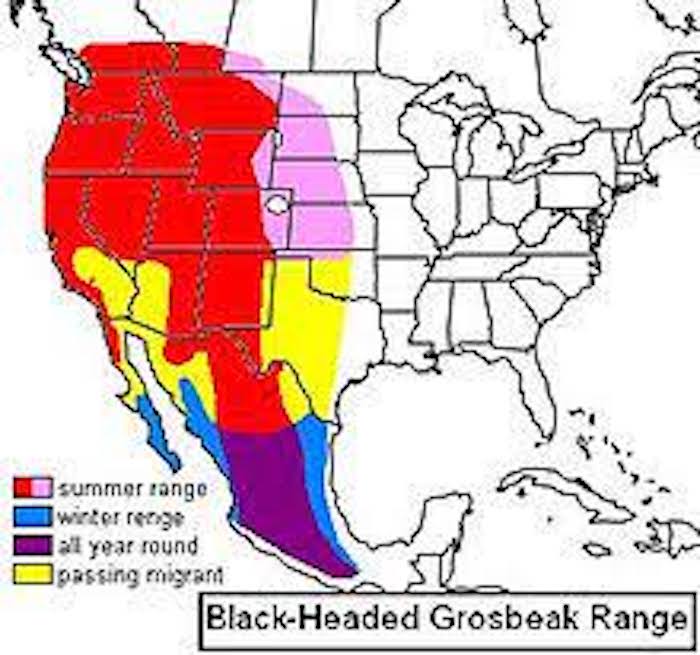Backyard Tales of a Black-headed Grosbeak and a Western Tanager

Black-Headed Grosbeak
Photo Credit – Author
The fall migration is underway. There are birds appearing in my Northern California backyard which I have not identified before. First there was the Black-Headed Grosbeak, a member of the Cardinal family, inspecting my bird feeder, probably looking for its favorite seed, the sunflower, and then there was a terrible accident involving a Western Tanager. These are not rare birds in California, just unusual in my backyard.
 Black-Headed Grosbeak Range
Black-Headed Grosbeak Range
Photo Credit – Wikipedia
The Black-Headed Grosbeak is a medium sized bird, about the size of a Starling, and is widespread and common in most parts of California, with its numbers appearing stable. It breeds as far north as southwest British Columbia. The average life span is approximately seven years. It chooses oak and mixed woodland for its summer habitat, but as it starts to migrate during September, to spend up to seven months wintering in central Mexico, it tends to choose open woodland, trees alongside streams, and suburban areas, as its preferred environment.
 Black-Headed Grosbeak, Both Sexes
Black-Headed Grosbeak, Both Sexes
Photo Credit – US National Park Service
The plumage of the male and female is somewhat different, but both genders possess a deep, conical beak, which gives the bird its name. The male has a black head, black speckled white back and tail, and an orangish neck, breast, and sides. The female is browner, with a whitish belly and streaking on the sides.
Their diet is mainly insects, snails, and spiders during summer, but they switch to seeds, berries, and fruit in winter. They are one of the few birds that eat monarch butterflies, despite the noxious chemicals these insects contain after eating milkweed during their larval stage.
 Spotted Towhee
Spotted Towhee
Photo Credit – Sacramento Audubon Society
Beware of confusing the Black-Headed Grosbeak with a Spotted Towhee. The latter can be distinguished by its smaller bill and longer tail, and the orange coloring is restricted to its sides.
 Evening Grosbeak
Evening Grosbeak
Photo Credit – American Bird Conservancy
 Blue Grosbeak
Blue Grosbeak
Photo Credit – American Bird Conservancy
 Rose-breasted Grosbeak
Rose-breasted Grosbeak
Photo Credit – American Bird Conservancy
There are other species of Grosbeak to be found in California, such as the Evening Grosbeak, so-named because, at first, it was thought only to sing at dusk, the Blue Grosbeak, and the occasional Pine Grosbeak, which is widespread across northern Europe and Asia as well as North America. The Rose-Breasted Grosbeak breeds primarily in the forests of the eastern United States, and winters in central and southern Mexico, the Caribbean, Central America, and northern South America.
 Western Tanager, Male and Female
Western Tanager, Male and Female
Photo Credit – Rocky Mountain National Park Service
The Western Tanager that made it to my backyard unfortunately never left. It flew into a house window during the daytime, and died on impact. I hoped it was only stunned but that was not the case. I need to do something about my window!
 Fatal Accident
Fatal Accident
Photo Credit – Author
Glass windows are worse than invisible. They either reflect foliage and the sky, or face off against another window, and appear not to exist. Up to an estimated one billion birds die annually from window strikes in the United States. I am considering what I should do. Should I place decals or stickers on the window despite its large size? The alternatives include installing shutters, using a mosquito screen or netting, adding a series of rope bird-savers, or inside, maybe I could add blinds, the simplest solution.
 Western Tanager Range Map:
Western Tanager Range Map:
Photo Credit – Terry Sohl, NatureServe
Western Tanagers breed in the mountains of California, and as far north as Alaska, and winter in north-west Mexico, and as far south as central Costa Rica. Despite their name, the species is a member of the Cardinal family. They eat insects, fruit, and berries. Males are readily recognized by their bright red head, lemon-yellow breast and back, and black wings, shoulders, and tail. Both sexes possess a relatively small, light-colored beak. They are a couple of inches shorter than an American Robin and slightly smaller than a Black-Headed Grosbeak. Their typical life span, excluding accidents, is around eight years.
I await the arrival of my next unusual species of bird.



